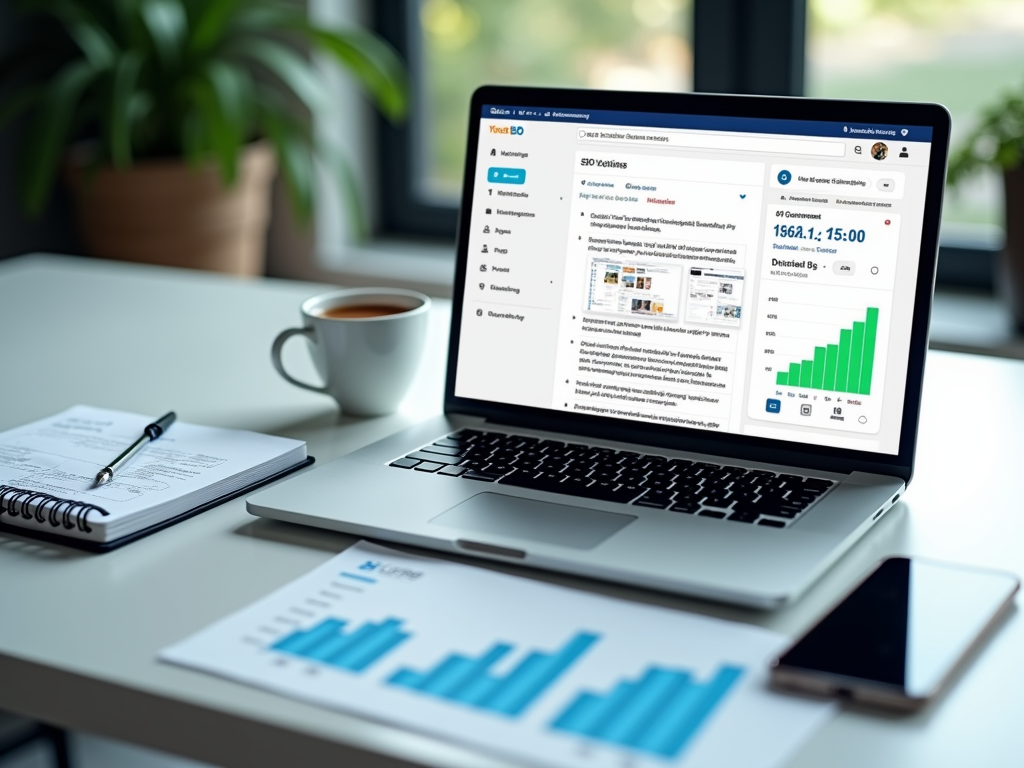![Complete Guide to Blog Post SEO Optimization in 2025 [Expert Tips]](https://v3.fal.media/files/koala/0qOUcna9BY3dBbHR5hfIg.png)
Table of Contents
83% of successful content marketers prioritize SEO optimization. In today’s digital landscape, blog post SEO is crucial for business growth, despite facing challenges like algorithm updates and increasing competition. This guide provides actionable solutions for modern content optimization.
Understanding Blog Post SEO Fundamentals

Mastering SEO Ranking Factors in 2025
The search engine optimization landscape continues to evolve rapidly, with Google’s algorithms becoming increasingly sophisticated in determining which content deserves to rank highest. Understanding these changes is critical for brands seeking organic growth through content marketing. With Creator’s AI-powered content generation platform, you can stay ahead of these developments while producing high-quality content that resonates with both search engines and your target audience.
Key Ranking Factors Google Considers in 2025
Google’s ranking factors have undergone significant transformation, prioritizing user experience and content quality above all else. The most influential factors now include content relevance, user engagement metrics, and technical performance indicators.
Content relevance remains paramount, with Google’s advanced natural language processing capabilities evaluating how thoroughly your content addresses search queries. This means comprehensive coverage of topics is more important than keyword density alone. Creator helps you develop this depth by analyzing existing high-performing content in your niche and suggesting comprehensive topic coverage.
User engagement signals have gained tremendous weight in Google’s algorithm. Pages that keep visitors engaged—with lower bounce rates and higher time-on-page metrics—receive preferential ranking treatment. This shift rewards brands that create genuinely valuable content addressing user needs rather than superficial pieces designed solely for search engines.
Mobile experience continues to be critical as Google maintains its mobile-first indexing approach. Sites offering seamless mobile experiences not only satisfy Google’s requirements but also meet the expectations of today’s predominantly mobile users. Creator ensures your content is optimized for all devices by following responsive design principles in its recommendations.
Page speed and Core Web Vitals have become non-negotiable ranking factors. Sites that load quickly and provide stable user experiences see significant ranking advantages. Creator’s platform integrates these technical considerations into its content recommendations, ensuring your articles are optimized for both readability and technical performance.
On-page vs. Off-page SEO Elements
On-page SEO elements remain directly within your control and serve as the foundation of any successful optimization strategy. These include content quality, keyword optimization, meta elements, and internal linking structures.
Content quality stands as the most critical on-page factor. Google’s algorithms now effectively identify comprehensive, accurate, and valuable information. Creator’s AI helps you develop expert-level content that satisfies these quality requirements while maintaining your brand’s unique voice and style.
Strategic keyword placement continues to matter, though in more sophisticated ways than before. Rather than focusing on keyword density, successful content incorporates semantic variations and related terms that demonstrate topical expertise. Creator’s platform automatically identifies these semantic keyword opportunities and suggests natural integration points throughout your content.
Technical on-page elements like schema markup, meta descriptions, and proper heading structures help Google understand and properly index your content. Creator’s platform guides you through implementing these technical aspects correctly, ensuring search engines can fully comprehend your content’s value.
Off-page SEO factors, while less directly controllable, remain crucial for competitive rankings. Backlink quality has evolved from a numbers game to a relevance assessment. A few high-quality, contextually relevant backlinks from authoritative sites now outweigh dozens of low-quality links.
Brand signals across the web, including social media mentions, branded searches, and online reviews, significantly impact how Google evaluates your site’s authority. Creator helps you develop content strategies that naturally encourage these valuable off-page signals through shareable, citation-worthy content creation.
Role of User Intent in Content Optimization
Understanding user intent has become the cornerstone of effective SEO strategy. Google’s algorithms now categorize searches by their underlying purpose: informational, navigational, transactional, or commercial investigation.
Informational intent drives most content marketing opportunities. Users seeking knowledge or answers require comprehensive, well-structured content that addresses their questions clearly. Creator’s platform excels at identifying these informational gaps and helping you develop content that perfectly matches this intent type.
Transactional intent requires different content approaches. Users ready to make purchases or take specific actions need concise, persuasive content that facilitates their journey. Creator helps you craft content that moves prospects through your funnel effectively while maintaining SEO value.
Intent-matching now requires deeper analysis than simply targeting keywords. It involves understanding the format, depth, and approach your audience expects when making specific queries. Creator’s analytics tools provide insights into how users engage with your content, helping you refine your intent-matching strategy over time.
User satisfaction signals have become Google’s north star for ranking decisions. Content that truly satisfies user intent—demonstrated through engagement metrics, sharing behavior, and return visits—consistently outperforms technically perfect but less satisfying alternatives. Creator’s platform helps you optimize for these satisfaction signals by focusing on creating genuinely valuable content tailored to your specific audience segments.
By leveraging Creator’s AI-powered content platform, D2C brands, SaaS companies, and content marketers can develop SEO strategies that align perfectly with these evolving ranking factors while maintaining their unique brand voice and content quality standards.
Essential On-Page SEO Optimization Techniques

On-Page SEO Optimization: A Complete Guide
Title Tag and Meta Description Best Practices
Title tags and meta descriptions are crucial first touchpoints between your content and potential visitors. These elements not only influence click-through rates but also signal relevance to search engines.
When crafting title tags, keep them between 50-60 characters to ensure they display properly in search results. Include your primary keyword near the beginning to maximize its SEO impact. For example, rather than “A Guide to Content Creation Tools,” use “Content Creation Tools: The Ultimate Guide for Marketers.” This front-loading approach helps both users and search engines immediately understand your content’s focus.
For meta descriptions, you have approximately 155-160 characters to work with. Use this space to create a compelling summary that includes your primary keyword naturally. Think of meta descriptions as mini-advertisements for your content. They should accurately represent what readers will find while enticing them to click through.
A common mistake is using identical meta descriptions across multiple pages. Each page deserves a unique, relevant description that differentiates it from others on your site. This approach not only improves SEO but also creates clearer expectations for users.
Remember to include a call-to-action when appropriate. Phrases like “Learn how,” “Discover,” or “Find out why” can significantly increase click-through rates by creating a sense of value and urgency.
Header Hierarchy and Keyword Placement
Proper header hierarchy does double duty—it organizes your content for readers while helping search engines understand your topic structure. This organizational framework impacts both user experience and SEO performance.
Start with a single H1 tag that contains your primary keyword. This main heading should clearly communicate what the entire page is about. Following this, use H2 tags to divide your content into major sections, and H3 tags for subsections within those larger segments. This creates a logical content hierarchy that’s easy for both readers and search engines to navigate.
Strategic keyword placement within headers significantly boosts your SEO efforts. Include your primary keyword in your H1, and incorporate relevant secondary keywords in your H2s and H3s. This approach helps search engines understand the relationship between different content sections and supports your overall topic focus.
When implementing keywords in headers, prioritize natural language over keyword stuffing. Headers like “Content Creation Best Practices for Marketing Success” read better than “Content Creation Tools Content Creation Software Content Creation Tips.” The former will perform better in search results because it matches natural search queries while remaining readable.
Properly structured headers also improve content scannability, allowing readers to quickly find relevant sections. This reduces bounce rates and increases time on page—both positive signals to search engines.
Image Optimization and Alt Text Strategies
Images enhance content engagement but require proper optimization to contribute to your SEO strategy. Unoptimized images can slow page loading times and miss valuable ranking opportunities.
Start by compressing all images before uploading them to your site. Tools like TinyPNG or built-in CMS compressors can reduce file sizes by 60-80% without noticeable quality loss. Aim for image files under 200KB whenever possible to maintain fast loading speeds.
Choose descriptive, keyword-rich filenames for all images. Rather than uploading “IMG_12345.jpg,” rename it to something relevant like “content-creation-workflow-diagram.jpg.” This simple step provides search engines with additional context about your image.
Alt text represents another crucial optimization opportunity. These descriptions serve two important functions: they improve accessibility for visually impaired users and provide search engines with information about your images. Create alt text that accurately describes the image while naturally incorporating relevant keywords.
For example, rather than generic alt text like “marketing image,” use “content creator using AI writing assistant to generate blog posts” for more descriptive and SEO-friendly alt text. Keep alt text under 125 characters to ensure compatibility across browsers and screen readers.
Consider implementing structured data markup for images when applicable. This additional code helps search engines better understand your images and can increase the chances of appearing in Google Image Search and rich results.
Lastly, ensure your images are responsive. Properly coded responsive images automatically adjust to different screen sizes, improving mobile user experience—a significant ranking factor in today’s mobile-first indexing environment.
Content Structure and Readability Optimization

Content Formatting Best Practices
Content formatting isn’t just about aesthetics—it’s a strategic approach that directly impacts user engagement, readability, and search engine performance. When content is properly formatted, visitors stay longer, engage more deeply, and are more likely to convert. Let’s explore the essential formatting strategies that can transform your content effectiveness.
Creating Scannable Content Formats
Most online readers don’t read—they scan. Studies show that 79% of users scan web pages rather than reading word-for-word. This scanning behavior makes content formatting crucial for information retention.
To create truly scannable content, start by implementing consistent heading hierarchies (H2s, H3s, H4s) that guide readers through your content logically. This structure not only helps human readers but also assists search engines in understanding your content organization.
Incorporate bullet points and numbered lists to break up dense information. These visual elements create natural stopping points that allow readers to digest information in manageable chunks.
White space is often overlooked but remains critical for readability. Generous margins and paragraph spacing reduce cognitive load and help readers focus on your message without visual overwhelm.
Use text formatting strategically—bold for key concepts, italics for emphasis, and different font sizes to establish information hierarchy. However, exercise restraint to avoid creating visual noise that diminishes rather than enhances readability.
Consider implementing these additional scannable elements:
• Information boxes for key takeaways • Custom blockquotes for important statements • Divider lines to separate distinct content sections • Icons to visually represent concepts
Remember that mobile optimization is non-negotiable. What looks scannable on desktop may appear cluttered on mobile devices, so always test your formatting across multiple screen sizes.
Optimal Content Length and Depth
Content length requirements vary significantly based on intent, topic complexity, and competition. While there’s no universal “perfect” length, data consistently shows that comprehensive content tends to outperform thin content for most search queries.
For informational content targeting competitive keywords, aim for 1,500-2,500 words to adequately cover the topic. However, length alone isn’t sufficient—depth matters more than word count. A thorough 1,200-word article often outperforms a 2,500-word piece that lacks substantive insights.
Consider these content depth principles:
- Answer the primary query completely before expanding to related topics
- Include specific data points, statistics and research findings to substantiate claims
- Address common questions and objections related to your topic
- Provide actionable takeaways rather than general advice
The optimal depth varies by audience segment as well. Technical audiences may require more detailed explanations, while time-constrained executives might prefer concise summaries with expandable sections for deeper dives.
When determining content length, analyze the top-ranking results for your target keywords. This competitive analysis often reveals the depth expectations for specific topics in your industry.
For D2C brands and SaaS companies, educational content generally performs best when it includes practical applications, implementation guidance, and real-world success metrics—even if this increases overall length.
Internal Linking Strategies
Internal linking is the connective tissue of your website, creating pathways for users and search engines to discover related content. Strategic internal linking supports SEO, enhances user experience, and increases time-on-site metrics.
Implement a hub-and-spoke model where cornerstone content (hubs) links to related supporting content (spokes). This architecture establishes topical authority and helps search engines understand your site’s information hierarchy.
When creating internal links, use descriptive anchor text that accurately represents the linked content. Avoid generic phrases like “click here” or “read more” in favor of keyword-rich anchor text that provides context about the destination page.
Establish these internal linking best practices:
• Link from high-authority pages to new content to help distribute page authority • Create contextual links within body content rather than relegating all links to sidebars • Ensure a reasonable link density (typically 2-4 internal links per 500 words) • Regularly audit and update internal links as your content evolves
For content marketers at D2C and SaaS companies, consider implementing a logical content progression through internal links. Guide readers from awareness-stage content through consideration and decision stages with strategic internal linking that supports the buyer’s journey.
Finally, use tools to identify orphaned content—pages with few or no internal links pointing to them. These orphaned pages often underperform because they lack the authority benefits that come from internal linking.
By implementing these formatting strategies, your content will not only become more engaging for readers but also more effectively communicate your expertise to search engines.
Advanced SEO Optimization Strategies

Advanced SEO Techniques for Content Marketers
Search engine optimization continues to evolve beyond simple keyword placement. Today’s most successful content strategies implement advanced techniques that enhance visibility, user experience, and search engine understanding. Let’s explore three powerful approaches that can transform your content marketing results.
Semantic SEO and Topic Clusters
Semantic SEO focuses on understanding the meaning behind search queries rather than exact keyword matching. This approach aligns perfectly with how modern search engines work by interpreting context, intent, and relationships between topics.
Topic clusters represent one of the most effective implementations of semantic SEO. This strategy involves creating a pillar page that broadly covers a main topic, with multiple related content pieces (cluster content) linking back to it. Each cluster piece targets more specific long-tail keywords related to the main topic.
For example, if your pillar content covers “content marketing strategy,” your cluster content might include detailed guides on “content calendar planning,” “audience research methods,” and “content distribution channels.” This interconnected structure signals topical authority to search engines.
To implement effective topic clusters:
- Identify your primary topics based on audience needs and search intent
- Create comprehensive pillar content that addresses the broad topic
- Develop specialized cluster content that explores specific aspects in depth
- Implement strategic internal linking between related pieces
- Update content regularly to maintain relevance
This approach not only improves SEO performance but also creates a better user experience by guiding visitors through related content in a logical way.
Mobile Optimization Techniques
With mobile devices accounting for over half of global web traffic, mobile optimization is no longer optional. Search engines prioritize mobile-friendly content, making this a critical factor in your SEO strategy.
Start with responsive design that automatically adjusts to different screen sizes. This ensures your content displays properly across all devices without requiring separate mobile versions. Test your content on multiple devices to verify the experience remains consistent.
Page speed is particularly crucial for mobile users. Optimize images by compressing them and implementing lazy loading so they only load when needed. Minimize CSS and JavaScript files to reduce loading times.
Consider these additional mobile optimization techniques:
- Use larger font sizes (minimum 16px) for better readability on small screens
- Implement adequate spacing between clickable elements (at least 44x44 pixels)
- Eliminate intrusive popups that disrupt the mobile experience
- Structure content with clear headings and short paragraphs for easy scanning
- Test your mobile experience with Google’s Mobile-Friendly Test tool
Remember that mobile optimization benefits both users and search rankings. Google’s mobile-first indexing means the mobile version of your content determines how it ranks in search results.
Schema Markup Implementation
Schema markup represents one of the most underutilized yet powerful SEO techniques. This structured data helps search engines understand your content’s context and can significantly improve how your pages appear in search results.
Schema markup is a specific vocabulary of tags that you add to your HTML to enhance the way search engines read and represent your page in SERPs. It can generate rich snippets—enhanced descriptions that appear in search results—including star ratings, event details, product information, and more.
Common types of schema markup for content marketers include:
- Article schema: Highlights key information about your content
- FAQ schema: Displays frequently asked questions directly in search results
- How-to schema: Shows step-by-step instructions in visual form
- Review schema: Displays star ratings and review counts
- Video schema: Provides thumbnail images and video details
To implement schema markup effectively:
- Determine which schema types are most relevant to your content
- Use Google’s Structured Data Markup Helper to generate the proper code
- Test your implementation with the Rich Results Test tool
- Monitor performance in Google Search Console
- Expand your schema usage as you create more diverse content
Schema markup doesn’t directly impact rankings but can significantly improve click-through rates by making your search listings more appealing and informative.
When these three advanced SEO techniques work together—semantic SEO with topic clusters, mobile optimization, and schema markup—they create a powerful foundation for content that performs exceptionally well in search results while providing genuine value to your audience.
Conclusion
Implementing effective SEO optimization requires consistent effort and attention to both fundamental and advanced techniques. By following these strategies and regularly updating your approach, you can achieve sustainable organic growth.
Ready to optimize your blog posts? Try Creator’s AI-powered platform for data-driven content optimization



